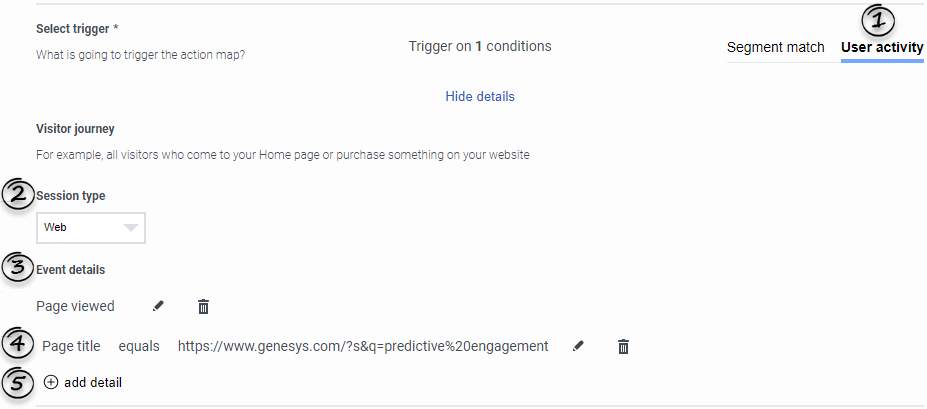Difference between revisions of "ATC/Current/AdminGuide/Trigger"
(Published) |
(Published) |
||
| Line 44: | Line 44: | ||
|structuredtext=If you haven't already, {{Link-SomewhereInThisVersion|manual=AdminGuide|topic=Tracking_snippet|display text=deploy the {{MINTYDOCSPRODUCT}} tracking snippet}} on the website to track. This snippet allows you to track standard {{Link-SomewhereInThisVersion|manual=AdminGuide|topic=Web_sessions|anchor=WebSessionEvents|display text=web events}}. To trigger an action map based on other events, use {{Link-SomewhereInThisVersion|manual=SDK|topic=Record|display text=ac('record')}} to send {{MINTYDOCSPRODUCT}} data about events that you want to track. | |structuredtext=If you haven't already, {{Link-SomewhereInThisVersion|manual=AdminGuide|topic=Tracking_snippet|display text=deploy the {{MINTYDOCSPRODUCT}} tracking snippet}} on the website to track. This snippet allows you to track standard {{Link-SomewhereInThisVersion|manual=AdminGuide|topic=Web_sessions|anchor=WebSessionEvents|display text=web events}}. To trigger an action map based on other events, use {{Link-SomewhereInThisVersion|manual=SDK|topic=Record|display text=ac('record')}} to send {{MINTYDOCSPRODUCT}} data about events that you want to track. | ||
| − | Select the session type and then select an event that triggers the action map. To trigger the action map when specific conditions are met, define one or more conditions (attributes). If you specify multiple conditions, the action map triggers when a visitor matches '''all''' the conditions. {{MINTYDOCSPRODUCT}} evaluates conditions in the order that you define them. For more information, see {{Link-SomewhereInThisVersion|manual=AdminGuide|topic=AttributesJourney|display text=visitor journey attributes}}. {{NoteFormat| | + | Select the session type and then select an event that triggers the action map. To trigger the action map when specific conditions are met, define one or more conditions (attributes). If you specify multiple conditions, the action map triggers when a visitor matches '''all''' the conditions. {{MINTYDOCSPRODUCT}} evaluates conditions in the order that you define them. For more information, see {{Link-SomewhereInThisVersion|manual=AdminGuide|topic=AttributesJourney|display text=visitor journey attributes}}. {{NoteFormat|You can trigger an action map based on visitor activity '''and''' an outcome probability. However, you cannot trigger it based on visitor activity '''and''' visitor segment matches.|}} |
|Status=No | |Status=No | ||
}}{{Section | }}{{Section | ||
| Line 52: | Line 52: | ||
|Media=Image | |Media=Image | ||
|image=ConfigureOutcome.png | |image=ConfigureOutcome.png | ||
| − | |structuredtext=You can trigger an action map based on the probability of a visitor achieving a given business outcome, based on the behavior of visitors who achieved that outcome previously. | + | |structuredtext=You can trigger an action map based on the probability of a visitor achieving a given business outcome, based on the behavior of visitors who achieved that outcome previously. |
| + | |||
| + | For more information about how to define outcome probabilities, see {{Link-SomewhereInThisVersion|manual=AdminGuide|topic=About_outcomes}}. | ||
|Status=No | |Status=No | ||
}} | }} | ||
}} | }} | ||
Revision as of 17:27, February 22, 2021
Contents
Learn how to define a condition that causes Genesys Predictive Engagement to offer an action map to a particular visitor.
Prerequisites
- Configure the following permissions in Genesys Cloud:
- Journey > Action Map > Add, Delete, Edit, and View (to create action maps)
- Journey > Action Target > View (to select a team to handle interactions from the action map)
- Deploy the Genesys Predictive Engagement tracking snippet on the website that you want to track (to trigger the action map based on event conditions)
- To trigger an action map based on other events, use ac('record') to send Genesys Predictive Engagement data about events that you want to track.
- Create segments.
- Create outcomes.
About triggering action maps
When you create an action map, you specify the conditions, or triggers that qualify it for a visitor. A visitor cannot qualify for the same action map multiple times in a single session. If multiple action maps qualify, the priority of each action map determines which one Genesys Predictive Engagement offers to the visitor. For more information, see Prioritize an action map.
You can trigger action maps based on:
Trigger based on segment match
Trigger based on visitor activity
If you haven't already, deploy the Genesys Predictive Engagement tracking snippet on the website to track. This snippet allows you to track standard web events. To trigger an action map based on other events, use ac('record') to send Genesys Predictive Engagement data about events that you want to track.
Select the session type and then select an event that triggers the action map. To trigger the action map when specific conditions are met, define one or more conditions (attributes). If you specify multiple conditions, the action map triggers when a visitor matches all the conditions. Genesys Predictive Engagement evaluates conditions in the order that you define them. For more information, see visitor journey attributes.Trigger based on outcome probability
You can trigger an action map based on the probability of a visitor achieving a given business outcome, based on the behavior of visitors who achieved that outcome previously.
For more information about how to define outcome probabilities, see About outcome predictions and probabilities.


